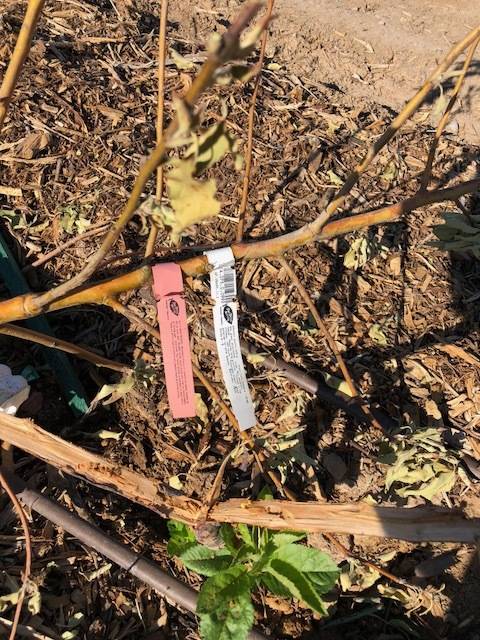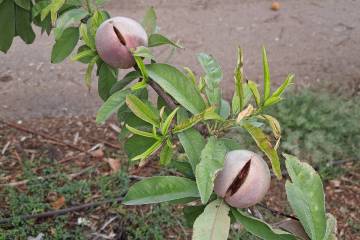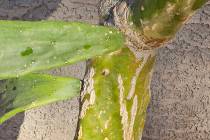Standard-sized apple tree cannot be pruned to dwarf size
Q: I watched your pruning videos on YouTube and learned a lot. Is it possible to reduce the size of a standard-sized apple tree to a dwarf size this way?
A: Probably not. Standard-sized apple trees may grow to 35 or 40 feet in height. You might be able to keep a standard-sized tree under 20 feet tall (maybe 15 feet if you’re really aggressive) through pruning, but I don’t think you will get it to 8 feet tall, which is what I aim for in pruning semi-dwarf trees for backyards. I call the size of these fruit trees “ladderless.” The standard-sized apple tree is just too vigorous for pruning to short heights.
Standard-sized apple trees normally grow 30 to 40 feet tall. Buying these trees on semi-dwarfing rootstocks will keep them smaller than this, but it depends on which semi-dwarfing rootstock the tree has been grafted onto. I have found that the M111 semi-dwarfing apple rootstock is probably best for backyards in our climate.
Using this semi-dwarfing rootstock, I have been able to keep Pink Lady and Mutsu apples, for instance, pruned at 8 feet through appropriate pruning methods. Apple trees grafted onto M111 rootstock will normally get to 80 percent of its mature height if left unpruned.
Nurseries sell fruit trees with a tag that calls the tree “semi-dwarf” because most people don’t know the different kinds of semi-dwarfing rootstocks. In our area, an apple that is labeled as semi-dwarf is most likely grafted onto M111 rootstock. There are online stores for fruit trees, such as Grow Organic and Bay Laurel, that specify the rootstock used, and the most common semi-dwarfing rootstock available on apples for backyards in the West is M111.
Q: I grow a lot of different plants in nursery containers in my yard. This past spring, I found three white grubs in the soil in one 5-gallon container. I also found them in the soil in my yard when planting new roses and trees. I’ve been manually picking them out and tossing them on the driveway for the birds to eat when I see them. Are they a threat to my flowers and veggies? Should I take any action against them?
A: Finding large white grubs in the landscape where the soil has been improved is normal during the spring months. However, finding a lot of white grubs in landscape soils is not a good thing, because they can eat the smaller young roots of plants as well.
Personally, I wouldn’t be overly worried if I found one white grub in a 5-gallon nursery container full of soil, but three is excessive. I would take some action.
This is the immature grub of a scarab beetle, sometimes called a June beetle. When temperatures begin to warm, the beetles pupate in the soil and emerge in summer as a flying adult seeking the opposite sex and a place to lay its eggs if it’s female. Your landscape sounds like it’s a playground for these guys.
Probably one of the most frequent June beetles we see flying in the summer months is the metallic green June beetle. When flying out and about, they love to eat white Kadota figs and just about any soft fruit that’s ripe. But during summer months, we also see the brown June beetles, which are another type of scarab beetle.
Adult female beetles lay eggs in midsummer. The female picks spots to lay her eggs where there’s plenty of food for her young to eat. She hones in on soils that have been amended with compost, since these young white grubs favor ripe or decaying organic plants mixed in the soil. Young tender roots of plants are mingled with decaying soil organics, and they’ll feast on both. That’s the problem.
Traditional pesticides such as Sevin applied to the area as a soil drench will easily kill these grubs if you lean in that direction. Sifting through the soil when you’re planting and handpicking them like you’re doing will get rid of most of them if you are organically inclined. Using milky spore bacterium for biocontrol only works if these white grubs are related to Japanese beetles. Most of our white grubs are not.
A preventive measure for future years is mixing beneficial nematodes into the soil that pursue various types of white grubs and not just the Japanese beetle. Your local garden center may carry beneficial nematodes, but they should be refrigerated when buying them. The best time to apply them is usually around August after egg-laying has finished and the young grubs are starting to gain some size.
Beneficial nematodes should be kept in the dark and in the refrigerator until they are ready to be mixed in the soil. They will have directions for their use on their label.
Q: I have mature Texas privets that I neglected to prune back during the winter. They are now sprouting out new growth. If I trim them back now, will that prevent future new growth this year?
A: No, it won’t. You can prune now without any problems. There is plenty of stored nutrition inside the larger stems for future growth. Japanese privets are versatile plants in the landscape and used either as small trees, shrubs or grown as a hedge. You didn’t say how you are using your plants.
If you are using Japanese privet as a formal hedgerow, then pruning with hedge shears is appropriate. Pruning plants with hedge shears is not appropriate for any other type of pruning.
Hedgerows are created by spacing plants slightly closer than their mature height. When pruning plants as a formal hedge, the top of the hedge should be pruned slightly narrower than the bottom of the hedge. Informal hedgerows are not pruned with hedge shears but hand shears, aka hand pruners. Informal pruning is best left to the commercial experts.
When pruning with hand pruners or loppers, pruning cuts are made deep inside the plant canopy, removing only a few of the larger stems to re-establish their size.
Q: Is there any risk to my chinaberry tree from the ivy that has grown exponentially through the canopy of this tree during the past few years? It was kind of charming when there were just 4 or 5 feet of ivy on the trunk, but now it looks a little too successful. Should I rip it off and, if so, how? The chinaberry tree is more important to me than the ivy.
A: I looked at the pictures you sent to me, and you’re right. The vine is an ivy. Probably English ivy. Two things you should be thinking about with English ivy growing in the chinaberry is what kind of damage it can create for your tree and, secondly, how much shade it might produce if it gets a foothold throughout the tree canopy.
From the pictures, it’s obvious to me that both plants are successful in that spot, and it does look nice to have the ivy climbing on the tree. Congratulations.
Is that a single vine climbing that tree trunk, or are there multiple vines? If there are multiple vines coming from the soil around the tree, then pull the oldest one, or the one with the thickest stem, off the trunk. Cut it 2 or 3 inches above the soil. This will cause the vine to grow multiple shoots up the trunk and keep it young.
When you pull English ivy from anything, it leaves woody aerial roots behind still attached where the vine was attached to the tree. That’s normal for ivy, and it’s one of its problems when it’s allowed to climb things. But the new growth of the young vines will cover anything unsightly left behind on the trunk when it’s pulled off.
If the vine is starting to climb inside the canopy of the tree, prune this growth back to the largest limbs or the trunk. You don’t want the vine growing inside the canopy and smothering the tree. That will happen as you suspected. You might have to carefully prune it back two or three times a year to keep it under control.
If there is only a single vine climbing the trunk of the tree, then I would cut the single vine 2 or 3 inches above the soil and allow it to regrow up the trunk from several locations rather than just one. After it climbs the trunk, you can pull off a larger vine such as I described earlier and still allow others to grow on the trunk.
Bob Morris is a horticulture expert and professor emeritus of the University of Nevada, Las Vegas. Visit his blog at xtremehorticulture.blogspot.com. Send questions to Extremehort@aol.com.





























